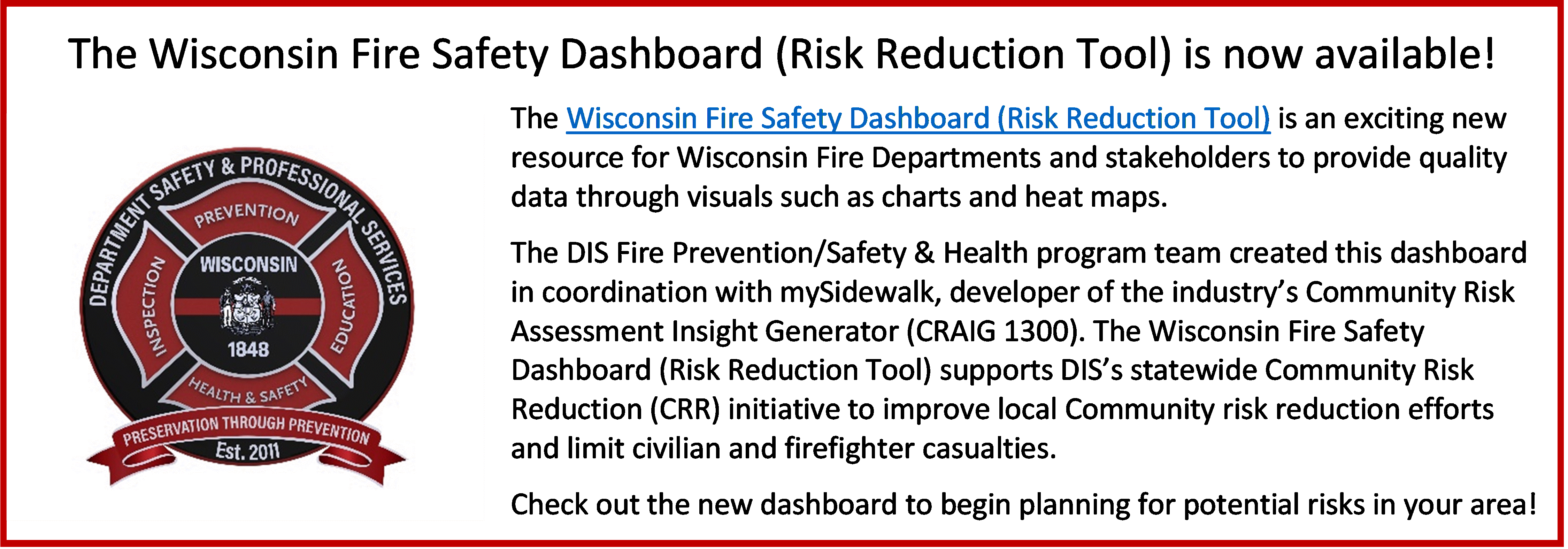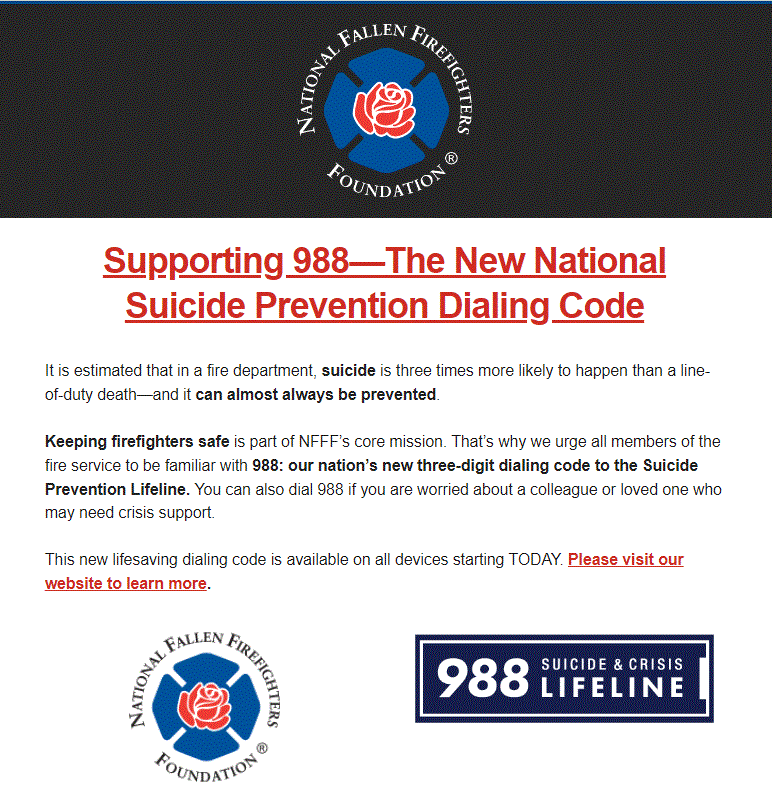NThe Division of Industry Services (DIS) provides services related to fire prevention, protection, fire department safety and health, NFIRS, and the administration of the 2% fire dues. DIS helps develop and enforces safety and health standards for public sector fire department employees, based on SPS 330, the Fire Department Safety and Health Code, and SPS 332, the Public Employee Safety and Health Code. (Related to SPS 332, SPS 330 contains minimum requirements for an occupational safety and health program for public sector fire department employees involved in fire department operations.)
Consultation and inspections are provided by Fire Prevention Coordinators on requirements for fire department safety and health programs. Staff also provide assistance to fire chiefs and inspectors in Wisconsin in support of fire prevention inspections. See also Fire Suppression and Fire Alarm Systems and
Commercial Buildings Programs.
Questions regarding fire prevention codes can be sent to
DSPSSBFirePrevention@Wisconsin.gov.
Subscribe to email updates on Wisconsin Fire Prevention, Fire Department Health & Safety, Wisconsin NFIRS, and/or Fire Dues!
Announcements
Check out the Year 1 report for Wisconsin's Fire Safety Dashboard Reduction Tool
here!
**************************************
See the DSPS Fire Prevention / FD Safety & Health Fall Training Schedule.
**************************************
The DSPS Fire Prevention group discussed Community Risk Reduction and the Wisconsin Fire Safety Dashboard at the February 2024 NFPA Kitchen Table. Watch the recording
here.
**************************************

**************************************
The DSPS standard on fire department safety and health identifies areas where fire departments must ensure that firefighters are limiting their risks and exposures to hazards or potential hazards that can be dangerous to their life and health. Many of the standards noted in SPS 330 are based upon best practices from NFPA 1500 or are directly referenced from OSHA standards. See the Firefighter Exposure Protection document for more information.
**************************************
Information on the new national suicide prevention dialing code:

Fire Incident Reporting
SPS 314.01(11) requires reporting of
ALL FIRES within 60 days of the incident through
NFIRS (FEMA). Fire departments shall follow the requirement within NFPA 1: 1.11.3.1 and keep a record every fire and other emergency incident that is encountered. We urge each fire department to report
ALL INCIDENTS to FEMA, not just fire incidents, to give a clear picture of what you do as a fire department, to keep your account active, and to assist with grant requirements.
SPS 314.01(13)(e) Availability of records. For at least 7 years, the records specified in par.
(d) shall be maintained in written form or in another form capable of conversion into written form within a reasonable amount of time; and shall be made available to the Department and to the public, upon request to the fire department.
Section
19.32 (2) of the Statutes considers a record to be material containing written or electromagnetic information. The Department considers computer records to be equivalent to written reports.
NFIRS Password Reset/Reactivate
In person training is currently not being scheduled. Training via the internet can be provided.
Contact us for more details.
For your awareness, education, and dissemination, see the eNFIRS training videos
here.
Multi-Year Data Trends in Wisconsin
Wisconsin NFIRS Email Updates
For news and alerts specifically geared toward users of the NFIRS, please subscribe to the Wisconsin NFIRS updates
here.
ImageTrend is now available to the Wisconsin Fire Service at no direct charge to the individual fire department. To get started using Wisconsin's version of ImageTrend Elite, contact us at
DSPSISNFIRS@wisconsin.gov.
Document
| Description
|
|---|
Overview
| ImageTrend Software Overview |

![]() NERIS for Wisconsin Fire Departments
NERIS for Wisconsin Fire Departments
This section provides information to help Wisconsin fire departments shift from the National Fire Incident Reporting System (NFIRS) to the National Emergency Response Information System (NERIS)..
NERIS is currently being rolled out by region across the nation and Wisconsin fire departments will be brought onboard beginning in December 2025. This section will help fire chiefs and other personnel prepare for the shift from NFIRS to NERIS.
What is NERIS?
Today's firefighters do much more than fight fires. NERIS is their new tool for gathering, reporting, and analyzing all-hazards incident data that focuses on risk, deployment, and performance.
NERIS was designed to provide fire service users with incident response data in near real-time, allowing them to make informed decisions that will enhance safety for firefighters, residents, and communities. As a flexible, scalable, interoperable tool that can adapt to reflect emerging issues, NERIS will integrate information from CAD systems, GIS, and other sources to provide detailed analytics anywhere, anytime, on smartphones, tablets, and desktops.
When Will NERIS be Implemented?
NERIS is already being rolled out regionally in the United States. Fire departments in Wisconsin will begin onboarding in December 2025. The full transition from NFIRS to NERIS is expected to be complete by December 31, 2025.
Recommendations for All Fire Departments
- Notify us when your department transitions to submitting live data to NERIS. Email
Sarah2.brown@wisconsin.gov with the actual date of the transition. If possible, schedule that transition for the first day of the month. (This will help ensure data continuity for your department.) Once you start reporting to NERIS you will stop reporting to NFIRS.
- All chiefs should select one or two additional department members to act as NERIS administrators, including a lead who will oversee NERIS onboarding and implementation. Unlike NFIRS, DSPS Fire Prevention/Safety & Health program will not initially have direct access to departments' profiles, so it's important to have at least one non-chief department member on the NERIS team for continuity of operations (in the event of retirements, etc). After you are onboarded to NERIS, you must send an “Invite” to
Sarah2.brown@wisconsin.gov and your
DSPS Fire Coordinator, so we have access to your fire departments profiles.
- Gather demographic information related to your department, including:
Basic information such as phone number, headquarters address, population currently protected, shift information, staffing levels, PSAP information, Automatic Vehicle Location usage, and dispatch protocols.
Geographic service boundaries such as first-due boundaries and districts within a department's service area.
-
Unit and apparatus inventory, including apparatus types.
-
Services your department provides include fire suppression, EMS, fire investigation, hazmat response, technical rescue, etc.
-
Interdepartmental relationships, including mutual, automatic, and contract aid, as well as specific services, if applicable.
- Decide if you want to share dispatch data with NERIS. If you use Computer-Aided Dispatch, ask your vendor if they have built a NERIS-compatible API and when it will be ready to start submitting data. Remember that you may have to work with another department/agency if dispatch doesn't report directly to your fire department.
- DSPS Fire Prevention/Safety & Health Program recommends departments work with their local legal counsel on requirements for records retention. After January 31, 2026, your legacy data in NFIRS will not be available to you. States/Fire Depts will only have access to the NFIRS PDR (Public Data Release).
Recommendations for Departments Using Third-Party Data-Reporting Software
- Departments currently using third-party reporting software should also select one or two additional NERIS leads/administrators. They will be important if you need to change your vendor, add or delete personnel, update your GIS boundaries, or update your department dashboard.
- These departments should also discuss NERIS compatibility with their vendors. Vendors that have successfully tested their Application Programming Interface (API) with NERIS will receive a NERIS Compatibility Badge. For the most up to date list of vendors that have received their NERIS badge, visit the
NERIS/FSRI webpage for Integration Partners. NFIRS software will not be compatible with NERIS, and on January 1, 2026, your NFIRS reporting will not carry over.
- These departments should consult with their vendors about access to past NFIRS reports and historical NFIRS aggregate data after they transition to NERIS.
NERIS General User Quick Start Video
NERIS Site Administrator Quick Start Video
Troubleshooting
- DSPS Fire Prevention/Safety & Health will update this section periodically as we become aware of bugs and fixes.
-
NERIS uses Multi-Factor Authentication to ensure data security, similar to NFIRS. This will require users to enter a time-limited access code emailed to them during login. Users on a small number of email platforms have reported that these emails arrive after the time limit expires. The NERIS team is working on this issue, and DSPS FPSH expects that it will be corrected by the time Wisconsin fire departments are being brought onboard.
Additional NERIS Resources and Assistance
NERIS Status Update: A PowerPoint presentation from the US Fire Administration on the latest developments in the ongoing transition to NERIS.
NERIS Educational Briefing: A PowerPoint presentation that gives an overview of the National Emergency Response Information System, its key features, and the onboarding process.
NERIS 2025 Rollout - What You Need to Know: A two-sided info sheet on the National Emergency Response Information System's 2025 rollout process.
NERIS Fact Sheet: A summary of the NERIS platform from the US Fire Administration and UL Fire Safety research Institute.
NERIS Briefing Slide Deck: A PowerPoint presentation that defines what NERIS will do, how it will benefit local departments and their communities, the rollout process, and the improvements it offers over NFIRS.
Explanation of Fire Department Dues Payments
The Division of Industry Services (DIS) arranges payments to municipalities under the Wisconsin Two-Percent Fire Dues Payments Program. As in past years, the
Current Year Distribution planned for each municipality is available. The list is first sorted alphabetically by county. Within the county, is sorted alphabetically by towns, villages, and cities. The amount of the check sent to the municipal treasurer is found under “Current Year Distribution.” This online list replaces the mailings that were done in the past to announce the amounts of the payments. If there are questions concerning the list, contact
DSPSSBFireDues@Wisconsin.gov.
Fire Dues Email Updates List
For news and alerts relating specifically to the 2% Fire Dues Fund (self-certification process, audits, and acceptable 2% expenditures), please subscribe to the 2% Fire Dues updates
here.
FIRE PREVENTION PUBLICATIONS
FIRE DEPARTMENT SAFETY & HEALTH PUBLICATIONS